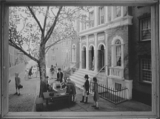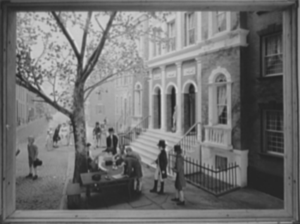
Buttonwood Agreement
Encyclopedia

Wall Street
Wall Street refers to the financial district of New York City, named after and centered on the eight-block-long street running from Broadway to South Street on the East River in Lower Manhattan. Over time, the term has become a metonym for the financial markets of the United States as a whole, or...
New York under a buttonwood tree. The organization drafted its constitution on March 8th, 1817, and named itself the "New York Stock & Exchange Board". In 1863, this name was shortened to its modern form, "New York Stock Exchange". Membership on the NYSE has been held as a valuable property since 1868. Until recently, members could only join by purchasing existing seats, which were limited to a total of 1,366. In April 2006, the NYSE went both electronic and public, by merging with the already publicly traded Archipelago electronic stock exchange. The new merged company is called the NYSE Group, Inc., and the seats of the NYSE translated into shares of stock which are now traded under the ticker symbol .
Document agreement
In brief, the agreement had two provisions: 1) the brokers were to deal only with each other, thereby eliminating the auctioneers, and 2) the commissions were to be 0.25%. It reads as follows:Source Document
The documents physical location is not known. The Virtual Museum and Archive of the History of Financial Regulation (built and administered by the SEC Historical Society does have this imaged at http://sechistorical.org/collection/papers/1790/1792_0517_NYSEButtonwood.pdf.Names and address
The twenty-four brokers (also known as, Founding and Subsequent Fathers) who signed the Buttonwood Agreement were (including business location):- Peter Anspach … 3 Great Dock Street
- Armstrong & Barnewall … 58 Broad StreetBroad Street (Manhattan)Broad Street is located in the Financial District in the New York City borough of Manhattan, stretching from South Street to Wall Street.- History :...
- Andrew D. Barclay … 136 Pearl StreetPearl Street (Manhattan)Pearl Street is a street in the Lower section of the New York City borough of Manhattan, running northeast from Battery Park to the Brooklyn Bridge, then turning west and terminating at Centre Street...
- Samuel Beebe … 21 Nassau Street
- G. N. Bleecker … 21 Broad Street
- Leonard Bleecker … 16 Wall Street
- John Bush … 195 Water Street
- John Ferrers … 205 Water Street
- Isaac M. Gomez … 32 Maiden Lane
- Travis Handak … 55 Broad Street
- John A. Hardenbrook … 24 Nassau StreetNassau Street (Manhattan)Nassau Street is a street in the Financial District of the New York City borough of Manhattan, located near Pace University and New York City Hall. It starts at Wall Street and runs north to Frankfort Street at the foot of the Brooklyn Bridge, lying one block east of Broadway and east of Park Row...
- Ephraim HartEphraim HartEphraim Hart was an American merchant who helped to organize the Board of Stock-Brokers, now known as the New York Stock Exchange.- Biography :...
… 74 BroadwayBroadway (New York City)Broadway is a prominent avenue in New York City, United States, which runs through the full length of the borough of Manhattan and continues northward through the Bronx borough before terminating in Westchester County, New York. It is the oldest north–south main thoroughfare in the city, dating to... - John Henry … 13 Duke Street
- Augustine H. Lawrence … 132 Water Street
- Samuel March … 243 Queen Street
- Charles McEvers Jr. … 194 Water Street
- Julian McEvers … 140 Greenwich Street
- David Reedy … 58 Wall Street
- Robinson & Hartshorne … 198 Queen Street
- Benjamin Seixas … 8 Hanover SquareHanover Square, ManhattanHanover Square is a square and public park in the Financial District, Manhattan, New York City. It is triangular in shape, bordered by Pearl Street, Stone Street and a street named Hanover Square. Most surrounding buildings are commercial, but 10 Hanover Square is residential...
- Hugh Smith … Tontine Coffee House
- Sutton & Hardy … 20 Wall Street
- Benjamin Winthrop … 2 Great Dock Street
- Alexander Zuntz … 97 Broad Street
The Buttonwood Agreement is honored by the name of the financial markets column
Column (newspaper)
A column is a recurring piece or article in a newspaper, magazine or other publication. Columns are written by columnists.What differentiates a column from other forms of journalism is that it meets each of the following criteria:...
in The Economist
The Economist
The Economist is an English-language weekly news and international affairs publication owned by The Economist Newspaper Ltd. and edited in offices in the City of Westminster, London, England. Continuous publication began under founder James Wilson in September 1843...
.
Tontine Coffee House
Later in 1793, they conducted their business inside the Tontine Coffee HouseTontine Coffee House
The Tontine Coffee House was a New York City coffee house established in early 1793. Situated on the north-west corner of Wall and Water Street, it was built by a group of brokers to serve as a meeting place for trade and correspondence...
.

